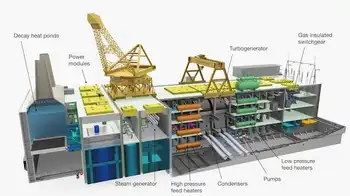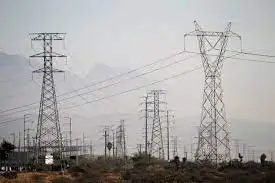5.2 billion dollars plus 5 years of construction 10,500 new jobs: Two nuclear reactors coming to Matagorda County
BAY CITY, TEXAS - Two new nuclear reactors at the South Texas Project in Matagorda County will create at least 6,000 jobs during construction and 1,000 permanent jobs upon completion.
"Happy days are here again," said Bay City Mayor Richard Knapik after NRG Energy Inc. announced the plan recently. "Every journey takes a first step. They have the confidence in STP. I'm just thrilled to be a part of it."
NRG, which is based in Princeton, N.J., filed a letter of intent on June 19 with the Nuclear Regulatory Commission to construct the two new reactors, increasing to four the number of reactors at the power plant.
The plant, which began operations in 1988, produces 2,500 megawatts of power.
Construction of the two units is expected to cost $5.2 billion and will be built using a new technology called Advanced Boiling Water Reactor, "the most advanced nuclear technology today," said David Crane, NRG's president and chief executive officer. "It is proven in design, proven in construction."
An application to build the two reactors will be filed with the NRC by the fall, said Joe Sheppard, chief executive officer and president of STP.
With approvals, construction may begin sometime in 2009, he said. The units will begin operation in 2014 with an additional capacity of 2,700 megawatts.
STP and the Public Utility Commission of Texas use different formulas for determining how many megawatts it takes to power an average household.
The power plant, on its Web site, estimates that its current reactors generate 2,500 megawatts that power 1 million households.
Paul Hudson, chairman of the PUC, said that the new reactors, generating 2,700 megawatts, will power "well over 2.5 million average homes."
The PUC, a spokesman said recently, uses a liberal estimation, taking into account all sizes of homes using maximum power at peak usage time.
"Announcements like this one demonstrate that the investment climate in Texas supports multibillion dollar risks," Hudson said. The population in Texas is expected to double by 2040.
Sheppard said the fact that STP has a safe and reliable existing power plant operation allowed NRG to plan for the expansion of its nuclear power generation. Original building plans announced for the power plant in 1973 were for four reactors. Only two were built.
Plans to construct the new reactors are part of a larger plan by NRG to develop about 10,500 megawatts of new generation facilities over the next 10 years, Crane said. The facilities will be spread across at least seven states for a total investment of $16 billion, "with the largest investment here in Texas."
"(STP expansion) is in many ways the most ambitious of our development opportunities," Crane said, "but environmentally and economically, it is also the most compelling."
NRG is a 44 percent owner of the nuclear power plant.
Other owners are the city of Austin's Austin Energy with 16 percent, and the city of San Antonio's CPS Energy with 40 percent.
The safe job STP has done in the past and its good relationship in the community is a large part of the reason NRG can proceed with plans to add two reactors, said Greg Westmoreland, Matagorda County judge.
"This is a good place to do business, and I think NRG knows that."
Matagorda County will need to use the next two years to plan for the inevitable increase in population and jobs, said D.C. Dunham, executive director for the Bay City Community Development Corp.
"We will need to put a plan in place for the future so we'll be able to provide the workforce that's needed and the housing that's needed for STP," Dunham said.
When STP built the first two reactors there was a high demand for housing, said Erwin Ward, a Coldwell Banker Realtor and a BCCDC board member.
"We need housing for 70,000 to 150,000 in the county," he said.
An estimated 6,378 jobs will be created in Matagorda County when the two new reactors are operational, according to a report by Ray Perryman, of the Perryman Group, an economic consultant.
Retail sales in the county could reach $1.7 billion, according to the report.
"The new reactors will be very good for existing retailers," said Owen Bludeau, executive director of the Matagorda County Economic Development Corp.
"In the past when they built the plant, the housing market exploded," he said. "But when construction crews left, much of the housing stayed vacant for a while."
The challenge for the county will be to find a way to retain the increase in population that will be felt during the construction phase.
Environmental concerns were among the principal drivers in the decision-making process of building two new reactors for electric power generation, Crane said.
Because nuclear power has zero carbon dioxide emissions, it is cleaner to operate than coal and gas generated power plants, Crane said.
"As we sit here in 2006, we as an industry need to recognize that the 800-pound environmental gorilla in the room is carbon emissions and their impact on global warming."
Related News

Europeans push back from Russian oil and gas
BERLIN - Europe is producing all-time highs of wind and solar energy as the 27-country group works to reduce its reliance on fossil fuels from Russia.
Four months after Vladimir Putin’s full-scale invasion of Ukraine in February 2022, the European Commission launched REPowerEU. This campaign aims to:
- Boost the use of renewable energy.
- Reduce overall energy consumption.
- Diversify energy sources.
EU countries were already moving toward renewable energy, but Russia’s war against Ukraine accelerated that trend. In 2022, for the first time, wind and solar power surpassed gas as a source of electricity. Wind and solar provided a record-breaking 22% of EU countries’ electrical supply,…




